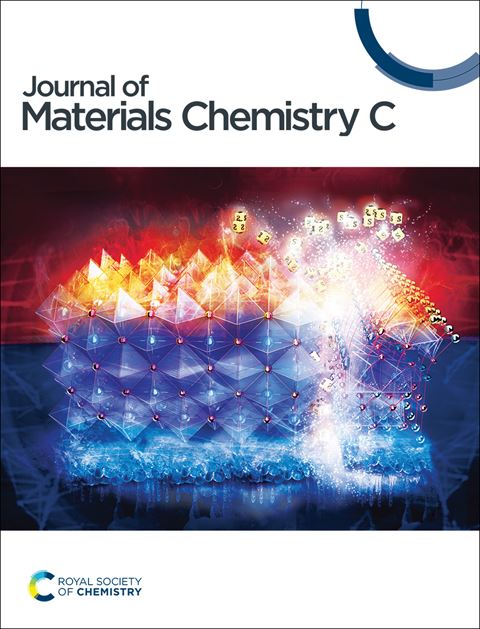Formation mechanism of micro-sized Cu plates using Br ions as basal plane-specific adsorbent and their application in the preparation of highly conductive and flexible Cu films
IF 5.7
2区 材料科学
Q2 MATERIALS SCIENCE, MULTIDISCIPLINARY
引用次数: 0
Abstract
A facile technique based on the aqueous chemical reduction of Cu–lactic acid complexes with ascorbic acid, in the presence of Br− ions as capping agents, was developed to synthesize micrometer-sized Cu plates (Cu MPLs). Crystal and surface analyses suggested that Br− ions were adsorbed on the basal planes of the 14-hedral particle seeds, and Cu was subsequently deposited on the side planes of the seeds, affording Cu MPLs. Electrochemical analysis and pH–potential diagrams of the reaction solutions revealed that the reduction pathway from Cu complexes to Cu without oxide formation was essential for facilitating the anisotropic growth of Cu crystals to obtain Cu MPLs. In addition, Cu thin films prepared by sintering a mixture of Cu MPLs and Cu nanoparticles (NPs) exhibited a lower resistivity (66 μΩ cm) at 200 °C than Cu NPs (129 μΩ cm) and a mixture of Cu NPs and three-dimensional (3D) and micrometer-sized Cu particles (3D MPs) (95 μΩ cm). This is because the Cu NPs act as a filler to bind the Cu MPLs or 3D MPs in the bimodal system. The number of voids in the NP and MPL mixture was lower than that in the mixture of NPs and 3D MPs because of the broad basal planes of the MPLs. Besides, the Cu film consisting of NPs and MPLs exhibited enhanced flexibility compared to the other films. We demonstrate that Cu MPLs are more suitable than 3D MPs for bimodal systems to achieve low resistivity and high flexibility at low sintering temperatures.

以 Br 离子为基面特异性吸附剂的微尺寸铜板的形成机理及其在制备高导电性柔性铜膜中的应用
研究人员开发了一种基于抗坏血酸水化学还原铜乳酸络合物的简便技术,在硼离子作为封端剂存在的情况下,合成了微米尺寸的铜板(Cu MPLs)。晶体和表面分析表明,硼离子被吸附在 14 多面体颗粒种子的基面上,随后铜沉积在种子的侧平面上,形成了铜 MPL。反应溶液的电化学分析和 pH 电位图显示,从铜络合物还原成铜而不形成氧化物的途径对于促进铜晶体的各向异性生长以获得铜 MPL 至关重要。此外,通过烧结 Cu MPLs 和 Cu 纳米粒子 (NPs) 的混合物制备的 Cu 薄膜在 200 °C 时的电阻率(66 μΩ cm)低于 Cu NPs(129 μΩ cm)和 Cu NPs 与三维 (3D) 和微米级 Cu 粒子 (3D MPs) 的混合物(95 μΩ cm)。这是因为在双模体系中,Cu NPs 起到了填充剂的作用,将 Cu MPLs 或 3D MPs 结合在一起。NP 和 MPL 混合物中的空隙数量低于 NP 和 3D MPs 混合物中的空隙数量,这是因为 MPL 的基底面很宽。此外,与其他薄膜相比,由 NPs 和 MPL 组成的铜薄膜具有更高的柔韧性。我们证明了铜 MPL 比三维 MP 更适合用于双模系统,在低烧结温度下实现低电阻率和高柔性。
本文章由计算机程序翻译,如有差异,请以英文原文为准。
求助全文
约1分钟内获得全文
求助全文
来源期刊

Journal of Materials Chemistry C
MATERIALS SCIENCE, MULTIDISCIPLINARY-PHYSICS, APPLIED
CiteScore
10.80
自引率
6.20%
发文量
1468
期刊介绍:
The Journal of Materials Chemistry is divided into three distinct sections, A, B, and C, each catering to specific applications of the materials under study:
Journal of Materials Chemistry A focuses primarily on materials intended for applications in energy and sustainability.
Journal of Materials Chemistry B specializes in materials designed for applications in biology and medicine.
Journal of Materials Chemistry C is dedicated to materials suitable for applications in optical, magnetic, and electronic devices.
Example topic areas within the scope of Journal of Materials Chemistry C are listed below. This list is neither exhaustive nor exclusive.
Bioelectronics
Conductors
Detectors
Dielectrics
Displays
Ferroelectrics
Lasers
LEDs
Lighting
Liquid crystals
Memory
Metamaterials
Multiferroics
Photonics
Photovoltaics
Semiconductors
Sensors
Single molecule conductors
Spintronics
Superconductors
Thermoelectrics
Topological insulators
Transistors
 求助内容:
求助内容: 应助结果提醒方式:
应助结果提醒方式:


